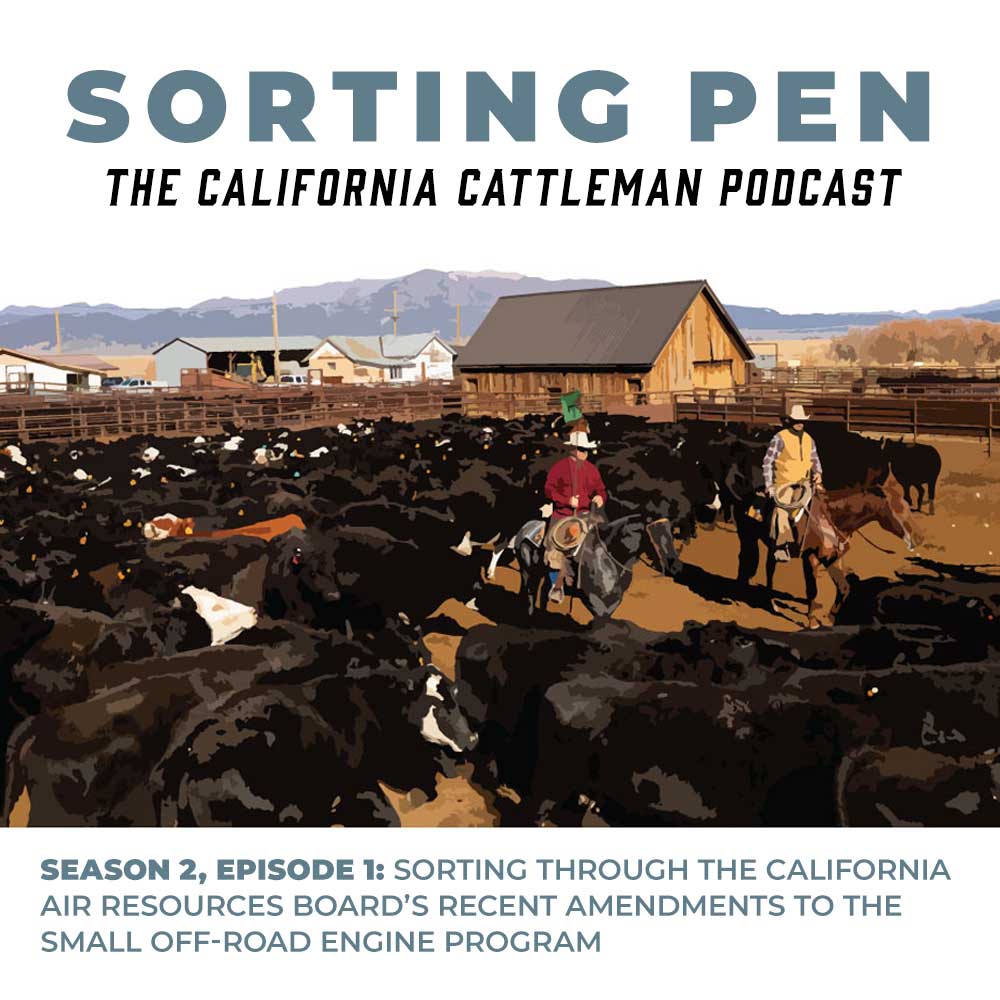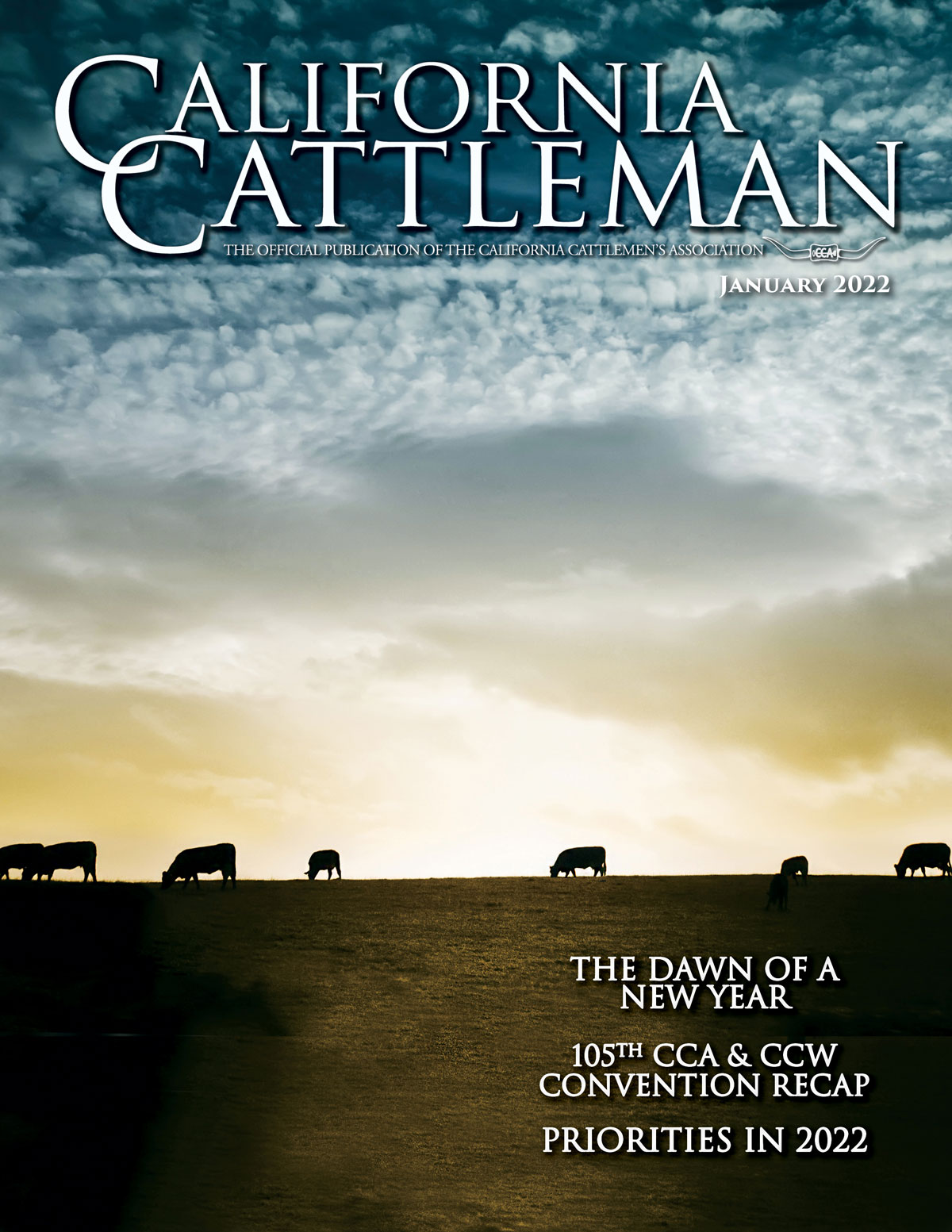
LEGISLATIVE BULLETIN
January 10, 2022
To read the full version each week, please subscribe below.
Governor Newsom Unveils Proposed 2022-23 Budget
Governor Gavin Newsom this morning unveiled the “California Blueprint” overviewing his proposed investments for the state’s Fiscal Year 2022-23 Budget. Bolstered by an estimated $31 billion budget surplus, the 2022-23 Proposed Budget totals $286.4 billion in state funding, eclipsing last year’s record $262 billion budget.
The Proposed Budget includes $1.2 billion in new funding for forest resilience and wildfire prevention over two years, including $482 million to enhance wildfire resilience. During his press conference unveiling the Proposed Budget today, Governor Newsom displayed a slide highlighting grazing’s role in forest health and fire resilience, and the Proposed Budget specifies that the wildfire resilience funding can be expended on a variety of CCA priorities such as “expanding grazing” and “utilizing prescribed fire.” The Proposed Budget also earmarks $382 million for strategic wildfire fuel breaks and $44 million for community hardening, among other funding priorities.
The Proposed Budget also includes $750 million in assistance to communities impacted by the drought, building upon the $5.2 billion approved last August in the “budget bill junior” for drought resilience and water projects. Of particular interest to ranchers, $40 million is proposed to be allocated to the Multibenefit Land Repurposing Program, which seeks to reduce irrigated agricultural land’s reliance on groundwater and includes projects aimed at repurposing lands as rangelands. $20 million would be earmarked to improve on-farm water conservation through the State Water Efficiency and Enhancement Program (SWEEP) and $10 million is proposed for drought relief and technical assistance for small farmers and ranchers.
Newsom proposes allocating $417 million under the umbrella of “Climate Smart Agriculture,” including $150 million for the FARMER program, which helps fund the replacement of agricultural equipment to reduce greenhouse gas emissions, $85 million for the Healthy Soils Program and $48 million in livestock methane emission reduction funding.
In addition to the above provisions – which fit within the Governor’s efforts to “Combat the Climate Crisis” – the Proposed Budget envisions $2.7 billion in additional investments to combat COVID-19, as well as substantial investments to confront homelessness, address rising costs of living and reduce crime rates.
CCA will continue to press for investments to expand grazing on state-owned lands and improve the state’s resilience to wildfire and drought ahead of the “May Revise” of the State Budget. Stay tuned to Legislative Bulletin and CCA’s other publications for updates as budget negotiations progress in Sacramento.
CNRA Provides Additional Opportunity for Public Feedback to Pathways to 30×30
As previously reported in Legislative Bulletin, last month the California Natural Resources Agency (CNRA) released the initial draft of Pathways to 30×30: Accelerating Conservation of California’s Nature. This triggered a 45-day public comment period that would have ended on February 1, 2022. On Wednesday, CNRA announced that the public comment period has been extended through February 15. Comments can be sent via email to CaliforniaNature@resources.ca.gov or uploaded to the Online Portal.
CNRA and the 30×30 Advisory Committee, which is made up of a selected group of stakeholders, will be holding a virtual advisory committee meeting this Wednesday from 3:00-5:00pm. Those interested in the 30×30 initiative are encouraged to follow along during this meeting, though there will likely be minimal opportunity, if any, for direct public engagement. The meeting agenda is available here and you can register for the meeting here.
CNRA will also be holding a virtual meeting on February 1 from 3:00-6:00pm to get public feedback on the Pathways to 30×30 document ahead of the public comment deadline. This is a great opportunity to provide rancher input on the 30×30 initiative and advocate for rancher-led conservation tactics such as grazing. If you would like to participate, you are encouraged to register ahead of time and provide up to two minutes of comment during the meeting. You can register to participate in the meeting here.
Lastly, CNRA issued a statement regarding the CA Nature Geographic Information System (GIS) mapping application. CNRA stated that it is aware that not all protected and properly conserved areas in the state have been identified as conserved for the purposes of the 30×30 initiative. On the CA Nature website, CNRA stated that CA Nature “contains protected areas whose conservation status could not be determined from immediately available data.” CNRA encourages landowners and land managers with direct knowledge and evidence of specific sites that may have been improperly identified in the Pathways to 30×30 document, to complete this survey and the information will be reviewed by the agency.
SWRCB Updates Curtailment Suspensions in Delta, Russian River and Scott River Watersheds
Last Monday, the State Water Resources Control Board (SWRCB) announced that all curtailments in the Sacramento-San Joaquin Delta (Delta) watershed remain suspended until tonight at midnight, unless otherwise extended. You can check the status of your water rights on the Delta Watershed Curtailment Status List. More information can be found on the Delta Drought webpage.
On Friday, the SWRCB announced that the temporary curtailment suspensions in the Russian River watershed will last through at least February 1. You can find more information on the drought response in the Russian River watershed on the Russian River Drought Response webpage.
The SWRCB also announced today that, due to current and predicted rain levels and flows at the United States Geological Survey Fort Jones gage, the temporary suspension of all curtailments in the Scott River watershed is extended through this Friday at midnight. This suspension is contingent on the flow requirement at the Fort Jones gage of 200 cubic feet per second being maintained. You can find more information on the Scott River and Shasta River Drought webpage.
For any questions about curtailment notices or how to comply, please contact the Ranchers Technical Assistance Program at (916) 409-6902 or rtap@wrstrat.com.
California Rangeland Conservation Coalition Rangeland Summit Goes Virtual
What’s the value of California rangelands and how can the ranchers who steward them help address the state and federal climate strategy goals of protecting 30% of land and water by 2030? Don’t miss the upcoming conversation that will happen surrounding this question at the 2022 California Rangeland Conservation Coalition Summit on January 24. This year’s Summit will happen completely virtually from 8:30am- 2pm. Register for the virtual Summit at https://carangeland.org/2022-summit.
Photos for the 2022 photo contest must be submitted by TODAY. Click here to get full details on this year’s photo contest.
New Episode of Stories from California Cattle Country
On this episode is a visit with Loren Poncia of Stemple Creek Ranch in Tomales and Eric Miller of V. Miller Meats, a Sacramento Butcher that has carried Stemple Creek beef since opening seven years ago. Click here, to listen and see photos from the ranch and butcher shop.
The episode is also available on a variety of platforms for streaming podcasts. Stories from California Cattle Country is produced by the California Cattlemen’s Foundation with support from the California Cattle Council.
Biden Administration Releases Action Plan for a More Competitive and Resilient Meat Supply Chain
Last week, the White House announced the “Biden-Harris Action Plan for a Fairer, More Competitive, and More Resilient Meat and Poultry Supply Chain.” Highlights of the Action Plan include $1 billion in American Rescue Plan funds to expand independent meat processing capacity; a commitment to issue new rules concerning the Packers and Stockyards Act and “Product of the USA” labeling in 2022; new enforcement efforts under Packers and Stockyards Act; and efforts to increase market transparency. For more information, see last week’s edition of Legislative Bulletin.
Biden Administration Solicits Information on America the Beautiful “Atlas”
The Biden Administration last Monday released a request for information to inform its development of an “American Conservation and Stewardship Atlas” which will guide how the Administration quantifies efforts to conserve 30% of the nation’s land and waters by 2030 via its “America the Beautiful” Initiative. The request for information is open for public comment (which can be submitted here) through March 7. For more information – including three upcoming virtual listening sessions hosted by the Administration, see last week’s edition of Legislative Bulletin.
Healthy Soils Program Incentives Program Application Period Open
The California Department of Food and Agriculture (CDFA) is accepting applications for the Healthy Soils Program Incentives Program until funds run out or by February 25. This program “provides financial incentives to California growers and ranchers to implement conservation management practices that sequester carbon, reduce atmospheric greenhouse gases (GHGs), and improve soil health.” CDFA is hosting one final workshop for information about the program on January 20 from 9-11am. To register for the virtual workshop click here; to learn more about applying click here.
Upcoming Industry Events
California Rangeland Conservation Coalition Rangeland Summit
January 24, Cabral Ag Center, Stockton
Click here to register and learn more.
Cattle Industry Convention & NCBA Trade Show
February 1-3, Houston
Industry News
CA releases draft proposal for state’s 30×30 plan Western Livestock Journal “Victoria Rodriguez, public policy advocate for California Cattlemen’s Foundation, told WLJ, ‘Though “agricultural easements” are not included within those GAP codes that are classified as already conserved, it is important to note that the draft states that these GAP codes are not all-encompassing, and the draft goes on to identify working lands as one of many conservation areas throughout the state. Additionally, the draft notes in several locations that sustainably managed ranches are an important and existing conservation strategy.’” To continue reading, click here.
California Beef Council Announces New Producer Relations Manager California Beef Council “The California Beef Council (CBC), the marketing order representing California’s cattle ranchers and beef producers, has hired Makenzie Neves as Manager of Producer Education and Engagement. This position coordinates producer education, engagement, and communication efforts for the CBC.” To continue reading, click here.
PG&E has been blamed for the Dixie Fire. Now what’s in store for the company? San Francisco Chronicle “Cal Fire confirmed this week what many in California already suspected: The Dixie Fire was caused by PG&E, when a tree fell onto the utility’s energized power lines last summer in a remote mountainous canyon.” To continue reading, click here.
Graduate Students Committed to Advancing Beef Industry National Cattlemen’s Beef Association “Kiera Leddy, Drake University Law School, and Maci Mueller, University of California (UC) Davis, have each been awarded a $15,000 W.D. Farr Scholarship by the National Cattlemen’s Foundation (NCF). The annual W.D. Farr Scholarship program, established by NCF in 2007, recognizes outstanding graduate students who plan to pursue careers furthering the beef industry.” To continue reading, click here.
New Episode of Sorting Pen: The California Cattleman Podcast
In December, the California Air Resources Board’s (CARB) approved new amendments to the Small Off-Road Engine (SORE). California Cattlemen’s Foundation Public Policy Advocate Victoria Rodriguez joins Katie in this first episode of season two to talk about these changes and about what this means for equipment important to ranching. To listen to the episode, click here.



